Wondering what forklift alternatives are out there?
Then you’re in the right place.
Because we’ve assembled 16 types of equipment that can supplement the common warehouse forklift. Not only that, but for each forklift alternative, you’ll learn:
- What it is (with real pictures)
- It’s advantages and disadvantages (compared to forklifts)
- The best applications for the equipment
- How much it costs
- Where you can find it
Let’s dive in!
16 Forklift Alternatives
1. Physical Labor

Description
Physical or manual labor involves using human employees to manually lift and move loads/materials. This is the way goods have been moved throughout history – until the invention of material handling machinery.
Cost Range
Physical labor can cost from minimum wage (currently $7.25 per hour per US federal law) to about $20+ per hour.
Applications
Physical labor can be used in practically any industry or warehouse setup since it’s the “default” material handling means.
But there are some limits.
Fifty pounds is a general guideline for the maximum weight a single person can lift. More weight than that requires more than 1 person or lifting equipment.
Pros
- Lower upfront cost than buying forklift/other material handling equipment
- A more affordable option for lighter loads/materials
Cons
- It can be time-consuming and may not be practical for all situations
- It can be hard to find labor, depending on budget, geography, economic conditions, and other factors
- It’s prone to injuries, fatigue, workers’ compensation costs, and other costs
- It’s not nearly as productive as a forklift
- Physical labor can’t lift as much weight as a forklift
Top Brands
To hire physical labor, use online services (like Indeed and/or ZipRecruiter), staffing agencies, job postings/boards, and local agencies.
2. Manual Pallet Jacks
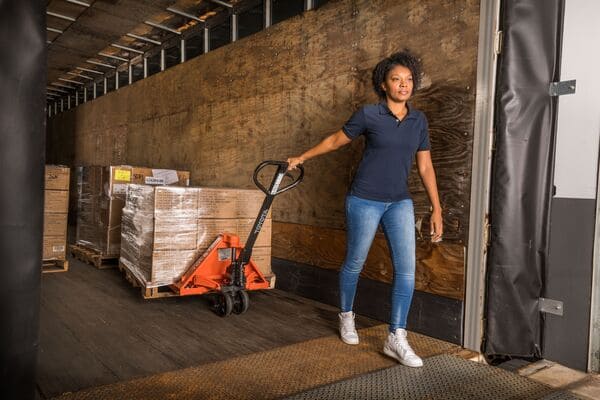
Description
Manual pallet jacks are machines designed to move pallets over short distances in factories, warehouses, retail, and grocery stores. In fact, they’re the simplest type of forklift
They’re also easy to operate: just pump the handle to lift pallets off the ground and move them around the warehouse or factory.
Costs
A manual pallet jack typically costs between $400 and $800, depending on the manufacturer, design, and other factors.
Applications
They’re commonly used in and personal warehousing operations to:
- Retail
- Grocery
- Food/beverage
- Warehouses
- Distribution centers
Pros
- Vastly more affordable than forklifts (lower initial and ongoing maintenance costs)
- Ideal for moving pallets in narrow spaces or locations with lots of much pedestrian traffic
- Enables unloading of trucks almost anywhere, with no loading dock required (provided the truck has a lift gate)
Cons
- Moving loads across a large facility with a manual pallet jack can be strenuous
- Injuries are more common with manual pallet jacks compared to forklifts
- Most models are limited to 5,500 lbs. lifting capacity
Top Brands
3. Lift Tables
Description
Lift tables are material handling equipment that raise and lower materials and workpieces to a comfortable height for workers.
Despite their exclusive function, lift models vary by size, capacity, elevation, and actuation to suit various highly specialized industrial processes. Common uses for lift tables include:
- Vehicle loading and docking
- Mobility impaired access
- Load positioning (when integrated into conveyor systems)
Costs
Lift tables range in price from $1,000 to $6,000 or more.
Applications
Industries that commonly use lift tables include
- Woodworking
- Manufacturing
- Metalworking
- Printing and publishing
- Warehousing and distribution
Pros
- Inexpensive relative to forklifts
- Less maintenance, wear, and potential for damage
- Mobility to be placed where the work is done
Cons
- Can’t move on its own power, rendering it stationary
- Can’t use for placing or retrieving items at height (can only raise/lower materials or work pieces)
Top Brands
4. Manual Forklifts/Material Lifts
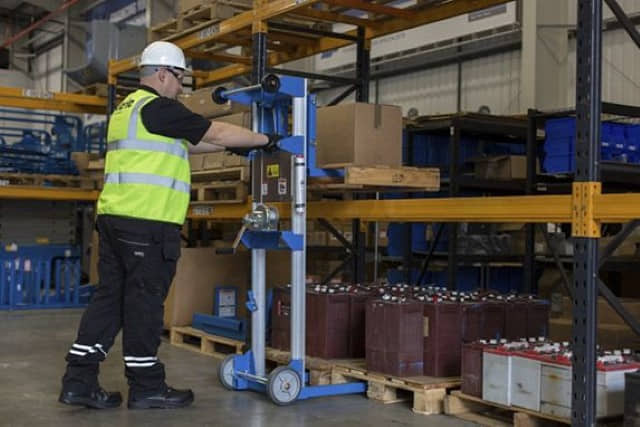
Description
Also called contractor lifts, manual forklifts are similar to forklifts but are operated manually by hand or foot. They can be more affordable than electric forklifts and are useful for lifting and moving loads in tight spaces.
Costs
Manual forklifts can cost between $2,000 and $4,000 or more.
Applications
The material lift is ideal for lifting and transporting:
- Materials
- Equipment
- Construction frameworks
- Transformers
- HVAC equipment
- Overhead piping
Pros
- Lower initial cost than forklifts
- Heavy-duty yet lightweight and portable
- Lower maintenance costs
- Some models can be easily loaded and transported via pickup truck
- Quick setup requires no tools
Cons
- Limited weight-lifting capacity (versus forklifts)
- Higher risks of worker injury, due to the requirement for manual placement and setup of the lift
Top Brands
5. Electric Pallet Jacks
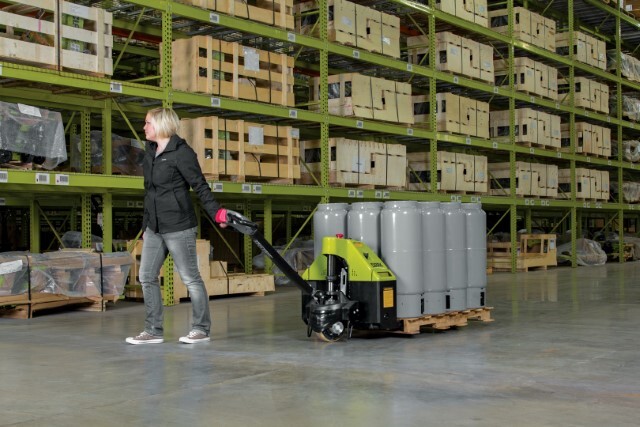
Description
Electric pallet trucks (also known as “powered pallet jacks,” “walkie pallet jacks,” and “power jacks”) are motorized industrial trucks designed to both lift and move palletized goods.
A powered pallet jack is generally moved forward or in reverse by a throttle on the handle and steered by swinging the handle in the intended direction
Costs
You can get electric pallet jacks for $5,000 to $7,000, depending on the manufacturer and capacity.
Applications
Power pallet jacks are ideal for transporting material horizontally over long distances. Common applications include:
- General warehousing
- Retail
- Manufacturing
- Food and beverage
- Cold storage
Pros
- Simpler than forklifts to operate
- Can move heavier loads than manual pallet trucks (6,000 to 8,000 lbs.)
- Better maneuverability than sit-down forklifts
- Less physical strain to workers when moving loads
Cons
- More expensive in both upfront and ongoing costs than manual pallet jacks
Top Brands
6. Utility Vehicles
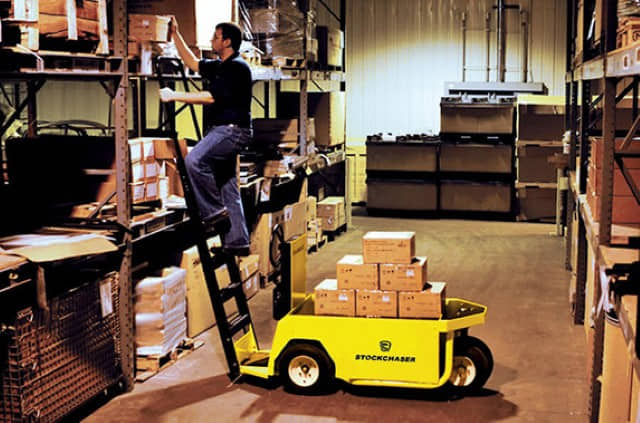
Description
Sometimes, you need to move large volumes of material/products around your facility. When a forklift won’t get it done, utility vehicles will deliver the versatile performance and mobility you need.
Utility vehicles come in various designs. But one common feature is an open back and low sides for easy loading and unloading. Other utility vehicle types include:
- Personnel carriers
- Burden carriers
- Stock chasers
Costs
Utility vehicles can cost from $3,000 to $10,000 or more depending on the design, manufacturer, and application.
Applications
- Moving people through facilities for tours and executive surveys
- Transporting maintenance teams and specialized supplies
- Moving materials and/or products in a warehouse or manufacturing plant
Pros
- A potentially more cost-effective way to move materials around your facility than via forklift
- Electric power systems are common in utility vehicles, requiring little maintenance
- Customizable to your specific needs
Cons
- Can have a higher initial cost compared to unpowered alternatives like manual carts
- Aren’t designed for lifting goods, only transporting horizontally
Top Brands
7. Tow Tractors
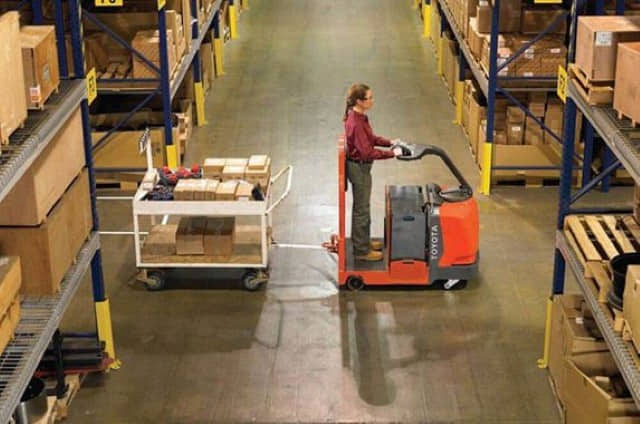
Description
Tow tractors are a type of utility vehicle designed specifically for pulling one or more loaded carrier carts. This makes them a great horizontal transportation solution for delivering materials, such as pallets or items, in a warehouse.
Tow tractors are an extremely cost-effective way to move pallets around your facility and can handle loads up to 60,000 lbs. While different tow tractors have unique sizes and specifications, most are equipped to travel long distances with their loads.
Costs
Tow tractors cost from $8,000 to $12,000 or more.
Applications
- General warehousing
- Logistics
- Airports
- Manufacturing
Pros
- Offer an efficient way to move many goods at the same time
- Long-distance horizontal transportation
- Variety of load carriers to suit many tasks
- Efficient and lean movement of goods
Cons
- Can’t lift materials – can only transport them horizontally
- May only be cost-effective for larger operations pulling many carts loaded with materials
Top Brands
8. Electric Stackers
Description
An electric stacker, or a walkie stacker, is a power-propelled device for lifting, loading, and moving pallets. They’re like forklifts but are more compact and have a smaller lifting capacity.
Stackers are a good alternative to traditional pallet trucks as they can lift from pallet racking or stacked pallets and move horizontally. Plus, they’re smaller, less cumbersome, and easier to maneuver compared to sit-down forklifts.
Primarily, an electric stacker is used for lifting and stacking loads or storing pallets on a shelf at a high level.
Costs
Electric stackers cost approximately $8,000 to $12,000 or more, depending on capacity, design, and manufacturer.
Applications
- Manufacturing
- Food and beverage
- Warehouses
- Grocery
- Retail
Pros
- Easier to maneuver than forklifts
- Cheaper than sit-down forklifts
- Can dramatically boost productivity over manual material handling
Cons
- More expensive than manual pallet jacks
- Can’t lift as much weight as a sit-down forklift
Top Brands
9. AGVs
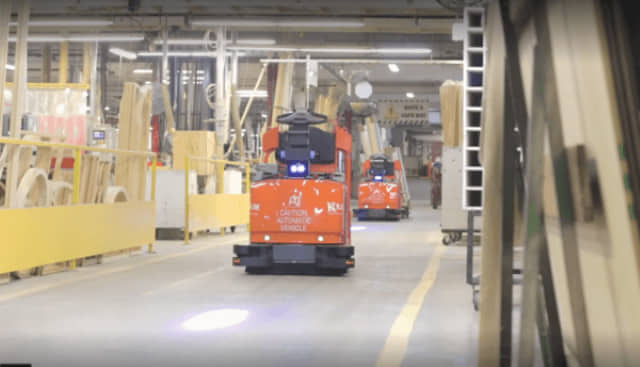
Description
Automated guided vehicles (AGVs) are computer-guided and pre-programmed robotic vehicles that can move materials around a warehouse or factory.
They can be programmed to travel autonomously, following specific paths throughout a warehouse, distribution center, or manufacturing facility, without an onboard driver/operator.
AVGs come in different types, which include the following:
- Carts
- Tuggers
- Forklifts
- Unit-load
- Heavy-haul
Costs
AVGs can cost anywhere from $20,000 to about $100,000 or more, depending on the type, design, manufacturer, and other factors.
Applications
- General manufacturing
- Automotive and aerospace
- Food and beverage processing
- Healthcare and pharmaceuticals
- Warehouses and distribution centers
Pros
- Increase efficiency and productivity (AGVs can work 24/7 with no breaks)
- Reduced reliance on manual labor
- Scalable to match business and production/throughput increases
- Can work in demanding conditions
Cons
- High coster of initial investment compared to other alternatives
- Downtime vulnerability if internet connection is lost
- Can be difficult to make changes to the guidance path if operations changes
- Limited to repetitive tasks
Top Brands
10. AMRs
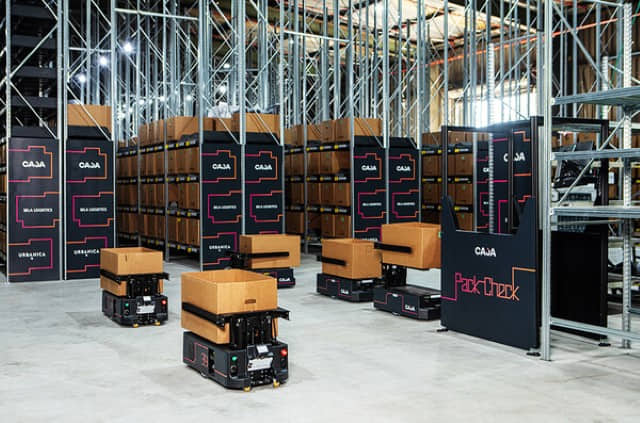
Description
Autonomous mobile robots (AMRs) are similar to AGVs but are more flexible and can adapt to changing environments.
Unlike AVGs, AMRs are not limited to a specific route but can make real-time navigational decisions without human intervention.
There are different AMR designs and models. But they can be classified into one of 3 groups based on the tasks that they perform:
- Picking and putting
- Inventory management
- Sortation
Costs
AMRs can cost from $20,000 to 100,000, depending on design type, manufacturer, and other factors.
Applications
AMR transport systems are designed to move, load, retrieve, sort, pick, or stack cases, totes, or carts. They’re used in different industries/areas, such as:
- Warehouses, particularly e-commerce
- Hospitals
- Airports
- Hazardous environments, like fire, nuclear, and military
Pros
- Highly flexible and autonomous
- Increased safety
- Quick implementation
- Ability to scale
- Easy to move the machines between facilities
Cons
- Higher initial cost than other alternatives
- May not be the best solution for smaller operations
Top Brands
11. Tractors (with Mast & Fork Attachments)
Description
Tractors with mast and fork attachments can be used as alternatives for forklifts to lift and move heavy loads. They are useful for outdoor applications and can be more versatile than traditional forklifts.
Costs
Tractors with a forklift attachment can cost from $20,000 to $100,000 depending on the tractor design, capacity, manufacturer, mast/attachment type, and specifications.
Applications
- Agriculture
- Factories
- Manufacturing
- Paper mills
- Construction
Pros
- Useful for outdoor applications
- More flexible and adaptable: you can replace the masts/attachments based on your activity
Cons
- Relatively expensive to buy tractors and masts/attachments (better if you already have a tractor and just need the forklift functionality)
- Can be difficult to implement
Top Brands
12. Skid Steers
Description
A skid steer is a truly multipurpose piece of construction equipment.
Its maneuverable and lightweight arms can attach to different tools for various construction and landscaping jobs. This reduces the need for more heavy-duty machines for different jobs.
One such attachment is the pallet fork. With this attachment, the skid steers becomes a forklift, offering high power in a small frame to perform heavy tasks in small spaces.
Costs
Skid steers can cost anywhere between $30,000 and $60,000 depending on the sizes and models you want.
Applications
- Agriculture
- Landscaping
- Construction
Pros
- Highly-versatile: 1 machine for many types of tasks
- Higher productivity: many attachments are “quick-change,” allow operators to quickly switch material handling tasks
Cons
- Limited lifting capacity compared to traditional forklifts
- May not be suitable for all material handling needs
- Higher initial cost
- May require different specialized training to operate different attachments
- You’ll also need different attachments for various jobs, each with an initial cost
Top Brands
13. Telehandlers
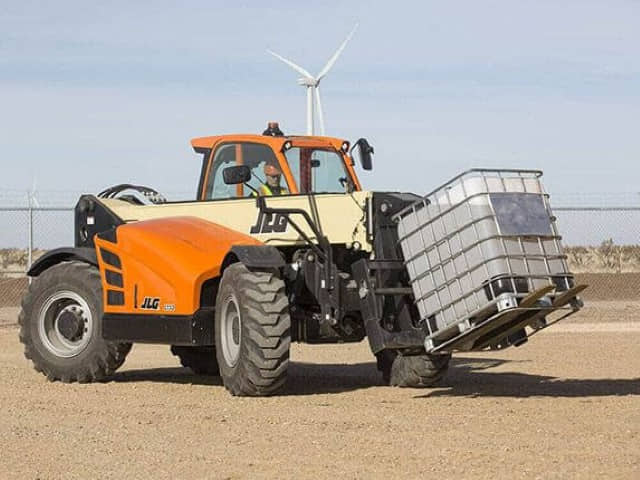
Description
Also known as a “boom lift” or “telescopic handler,” this is an innovative hydraulic lifting machine that carries and places heavy materials at heights.
Operators fix attachments (often a bucket) to the end of their boom to hold different materials. The attachment’s design defines the load it’s built to carry, such as forks for pallets or buckets for soil.
The most popular attachments for telehandlers are:
- Earthmoving bucket
- Fork tines
- Work platform
- Lifting jib
- Side-tilt carriage
- Material bucket
- Cubing forks
Costs
Telehandlers cost anywhere between $30,000 to $80,000, depending on the capacity, model, manufacturers, and other features.
Applications
- General material handling
- Sanitation and recycling
- Agriculture
- Construction
Pros
- Telehandlers offer more flexibility than forklifts with the ability to change attachments
- Heavy lifting: some models can lift 10,000 lbs.
- High reach: some models can reach 42 ft.
- On/off-road capabilities
- Work comfortably in outdoor, rough-terrain conditions
Cons
- Higher acquisition costs
- Limited capacity: even the largest telehandlers typically have a lower lifting capacity than forklifts
- Telehandlers are less maneuverable than forklifts or skid steers
- Telehandlers have many moving parts that require maintenance
Top Brands
14. Carry-Deck Cranes
Description
Carry-deck cranes are small, portable cranes commonly used in construction sites, industrial facilities, and other applications where heavy loads need to be lifted and moved.
Carry deck cranes are pick-and-carry cranes, built for lifting material that needs a low-profile and compact crane.
Because carry deck cranes are small, they’re ideal for operating in narrow spaces or around overhead obstacles.
The lifting capacity range of carry-deck cranes ranges from 8 to 15 tons. These industrial trucks are also equipped with a telescoping boom that can rotate 360 degrees.
Costs
The Costs of carry-deck cranes can vary depending on factors such as the manufacturer, lifting capacity, and features included.
On average, the price of a new carry-deck crane typically ranges from $30,000 to $100,000.
Applications
- Construction
- Manufacturing
- Warehousing
- Maintenance and repair
- Oil and gas
- Shipbuilding
Pros
- Can work on outdoor construction projects, such as prefabricated buildings or lifting equipment onto rooftops
- Higher lifting capabilities than forklifts
- Help in transporting materials and equipment around job sites when equipped with various attachments, such as pallet forks
- Carry-deck cranes are versatile and can work on a wide range of lifting and material-handling tasks
- Mobility: Carry-deck cranes are mobile and can be driven on roads and around job sites, making them easy to move from one location to another
Cons
- The boom of a carry-deck crane is relatively short, limiting the crane’s reach
- The operator’s view of the load being lifted can be obstructed by the boom of the crane, offering less visibility than other equipment
- Carry-deck cranes may not be as widely available as other equipment
Top Brands
15. Conveyors and Sortation Systems
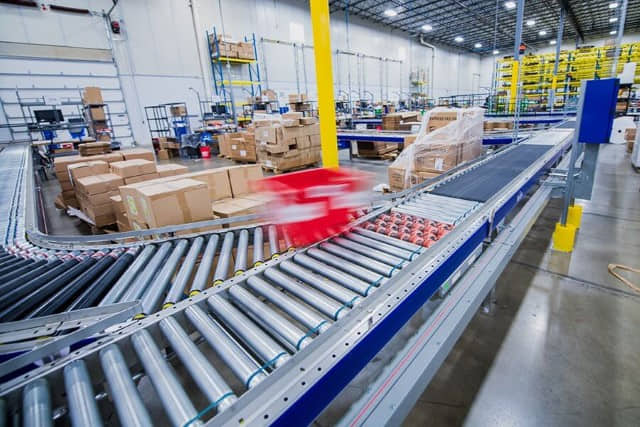
Description
Conveyors and sortation systems are material handling solutions that are widely used in many industries to transport and sort products or materials along a production line or through a warehouse.
Conveyors are used to moving items from one place to another, while sortation systems are used to sort and distribute items to their intended destination.
Costs
Generally, conveyors, and sortation systems are among the most expensive types of material handling systems. Their costs vary depending on the type of system, the level of automation, and the user’s specific needs.
Overall, conveyors and sortation systems cost from $50,000 to over $1 million.
Applications
Conveyors and sortation systems are used in a wide range of industries, including
- eCommerce
- Manufacturing
- Logistics
- Mining
- Automotive
- Agricultural
- Food and beverage
- Warehouse and logistics
Pros
- Increased efficiency: They increase efficiency, reduce labor costs and increase throughput
- Customizable: Conveyors and sortation systems are highly customizable to fit specific needs
- Scalability: They’re highly scalable, allowing businesses to expand and modify their systems
- Safety: Automated systems can help reduce the risk of accidents and injuries
- Space-saving: They save space in warehouses and other facilities by utilizing vertical space
Cons
- High initial investment: The cost of conveyors and sortation systems can be high, making them difficult for some businesses to afford
- Maintenance costs: The systems require regular maintenance to run efficiently
- Limited flexibility: Changing a system without significant modifications can be difficult once a system is installed
- Technical expertise: Operating and maintaining automated systems requires technical expertise, which may not be available in all businesses
- Limited mobility: Conveyors and sortation systems are typically fixed and cannot be easily moved around
Top Brands
16. Automated Storage and Retrieval Systems (AS/RS)
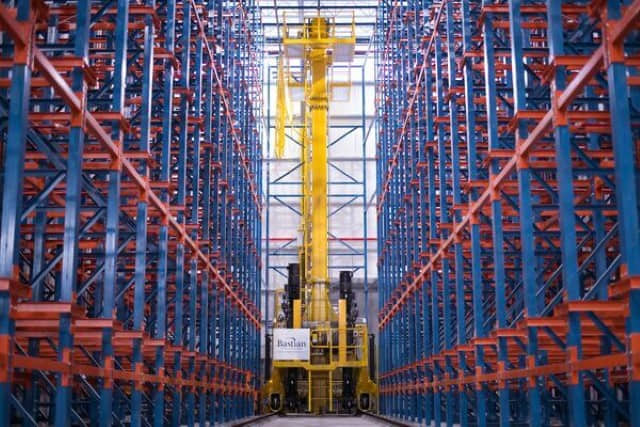
Description
Automated Storage and Retrieval Systems (AS/RS) advanced material handling technology used in warehouses and distribution centers to automate storing and retrieving products/materials for order fulfillment.
AS/RS consists of computer-controlled systems that use various technologies, such as conveyor systems, AGVs, and robotic arms, to handle the movement of goods.
There are two main types of ASRS systems:
- Unit-load: handles large and heavy pallets and cases from 1,000 to 5,500 lbs.
- Mini-load: handles light loads up to 75 lbs.
Costs
The cost of AS/RS can vary depending on the type of system, its complexity, and the size of the warehouse. Generally, AS/RS can cost from $70,000 to $1 million or more.
Applications
AS/RS is widely used in industries and companies with large inventories of products that need to be stored and retrieved quickly and efficiently, such as:
- Warehouses
- Automotive
- Food and beverage
- Pharmaceuticals
Pros
- Increased efficiency and productivity
- Improved accuracy and reduced errors
- Space utilization optimization
- Enhanced safety for workers
- Reduction in labor costs
- Better inventory control
- Reduction in product damage
Cons
- High initial cost
- Maintenance and repair costs
- Dependence on technology and automation
- Limited flexibility in adapting to changes
- High energy consumption
- Potential for system downtime
- Complex installation and integration process
Top Brands
Answers to Common Forklift Alternative Questions
What Can I Use Instead of a Forklift?
Here are 16 forklift alternatives:
- Physical labor
- Manual pallet
- Lift tables
- Manual forklifts/material lifts
- Electric pallet jacks
- Utility vehicles
- Tow tractors
- Electric stackers
- AGVs and AMRs
- Tractors (with a mast and forklift attachment)
- Carry-deck cranes
- Skid steers
- Telehandlers
- Conveyors/sortation systems
- Automated storage and retrieval systems (AS/RS)
How Do You Pick Up Pallets Without a Forklift?
If you don’t have a forklift or access to it, you can use manual pallet jacks or electric pallet jacks to pick up pallets. They’re a safe and efficient way to move pallets around a facility without using a forklift.
How Do You Move Heavy Objects Without a Forklift?
For strict horizontal travel from point A to point B, you can use:
- Pallet dollies
- Tow tractors
- Utility vehicles
- Conveyors/ sorters
- AS/RS
Alternatively, you can use manual forklifts or material lifts, electric stackers, tow tractors, skid steers, telehandlers, carry-deck cranes, or conveyors/sorters to move heavy objects without a forklift.
How Do You Load a Truck Without a Forklift?
Use manual pallet jacks, electric pallet jacks, lift tables, or tow tractors to load a truck without a forklift.
Can You Unload a Truck with a Pallet Jack?
If a dock or lift gate is attached to the truck, you may be able to unload the truck without a forklift using a pallet jack instead. But it also depends on the load’s weight and the pallet jack type.
What Is a Manually-Operated Forklift Called?
A manually operated forklift is also called a manual forklift or a hand-operated forklift.
Is a Pallet Truck the Same as a Forklift?
A pallet truck is different from a forklift. A pallet truck is a simple device used to lift and move pallets, while a forklift has a larger lifting capacity and is more versatile. Other key differences include:
- Pallet trucks are the simplest type of forklift
- They can be either manual or electric-powered
- Pallet jack lifting capacities range from 4,000 lbs. To 8,000 lbs.
- Pallet trucks can only lift loads a few inches off the ground
For example, a Toyota 8HBW23 electric pallet jack can lift 5.6 in. for a total elevated height of 9.1 in.
Can I Drive a Fork Lift Truck Without a License?
You cannot drive a forklift truck without a license. To operate a forklift truck, you need training and certification (according to OSHA’s guidelines). You can learn more about forklift licensing in Conger’s forklift license guide.
Can You Use a Skid Steer as a Forklift?
You can use a skid steer as a forklift by attaching either of 2 types of skid steer forklift attachments:
However, skid steers have limited lifting capacity compared to traditional forklifts and may not be suitable for all material handling needs.
Conclusion
That’s it: 16 forklift alternatives.
![16 Forklift Alternatives [Pros/Cons, Costs, and Applications]](https://www.conger.com/wp-content/uploads/2023/05/forklift-alternatives-featured-image-conger-industries.png)